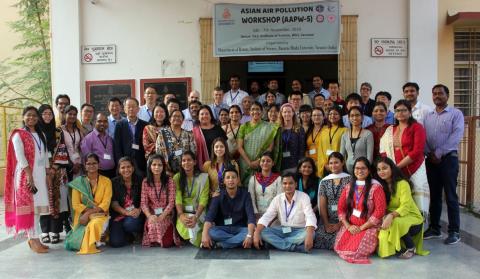
Blog article written by Dr Harry Harmens, UK Centre for Ecology & Hydrology
Dr Harry Harmens and Dr Felicity Hayes (CEH, Bangor) attended the 5th Asian Air Pollution Workshop, 5 – 7th November 2019, Varanasi, India, at Banaras Hindu University (http://www.aapw.net.cn). The timing of the meeting was very appropriate as air pollution reached very high levels in Delhi on 4th November 2019 (https://www.bbc.co.uk/news/world-asia-india-50280390), when Dr Harmens and Dr Hayes were passing through Delhi’s international airport. Similar air pollution levels were reached in Varanasi, with very high levels for short periods of time during the workshop.
Air pollution at Delhi’s airport, 4th November 2019
Dr Harmens and Dr Hayes were chair and rapporteur respectively of a session on “Development of ozone threshold values for different vegetation types in Asia”. Other thematic sessions included:
- Recent trends in types, sources and transport of air pollutants;
- Approaches to developing air pollution tolerance in vegetation;
- Responses of different vegetation types to air pollutant deposition;
- Role of environmental factors in air pollution sensitivity of vegetation
Dr Harmens was interviewed by the Indian newspaper ‘Danik Jagran’ (Varanasi edition) on the main air pollution problems and mitigation actions taken in the UK.
Interview with Dr Harry Harmens in Indian newspaper
On 7th November, an excursion was organised to the experimental sites at the Department of Botany and the Institute of Agricultural Sciences at Banaras Hindu University, and to Sarnath, a Buddhist pilgrim site near Varanasi. In the evening, a boating trip was arranged on the river Ganges.
As part of the CEH SUNRISE project (https://www.ceh.ac.uk/sunrise), Dr Harmens and Dr Hayes also helped the local organisers to organise a stakeholder meeting on 8th November, titled “Ozone pollution: A hidden threat to crop production”. Dr Hayes gave a presentation on “Ozone-induced visible leaf injury in crops” (linking to CEHs app: https://icpvegetation.ceh.ac.uk/get-involved/ozone-injury/record) and Dr Harmens gave a presentation on “Challenges (for feeding the world in a sustainable way) and options for mitigating adverse impacts of ozone on crops”. The meeting was attended by approximately 110 people, including scientists from different disciplines, crop breeders, agricultural extension workers, farmer representatives, village elders and farmers from villages nearby.
Presentations by Dr Felicity Hayes and Dr Harry Harmens at the stakeholder meeting
These and other presentations in the local language were followed by a lively discussion in the local language (with some translation provided). This enabled the mainly female local farmers present to take part in the question & answer session.
Participants at the stakeholder meeting and locals asking questions during a panel discussion session
The stakeholder meeting raised awareness of the threat of ozone pollution to food production in India and improved the knowledge on ozone-induced visible leaf damage symptoms amongst the stakeholders. At the same time, options for mitigating ozone pollution and its impacts on crops (through crop management) were presented.
Project NEC06476 (LTS-ODA SUNRISE), task 32 (Quantifying and mitigating the effects of ozone pollution on crop production) - https://www.ceh.ac.uk/sunrise
Related project: NEC06012 (Defra ICP Vegetation) - https://icpvegetation.ceh.ac.uk


